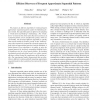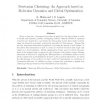39 search results - page 3 / 8 » Mixture Models and Frequent Sets: Combining Global and Local... |
ICDM
2007
IEEE
13 years 11 months ago
2007
IEEE
We propose an efficient algorithm for mining frequent approximate sequential patterns under the Hamming distance model. Our algorithm gains its efficiency by adopting a "brea...
CVPR
2005
IEEE
14 years 9 months ago
2005
IEEE
In [1], three popular subspace face recognition methods, PCA, Bayes, and LDA were analyzed under the same framework and an unified subspace analysis was proposed. However, since t...
NIPS
2007
13 years 8 months ago
2007
Clustering is often formulated as the maximum likelihood estimation of a mixture model that explains the data. The EM algorithm widely used to solve the resulting optimization pro...
EMMCVPR
2003
Springer
14 years 20 days ago
2003
Springer
The asymptotic distribution of estimates that are based on a sub-optimal search for the maximum of the log-likelihood function is considered. In particular, estimation schemes that...
PR
2007
13 years 7 months ago
2007
Given a data set, a dynamical procedure is applied to the data points in order to shrink and separate, possibly overlapping clusters. Namely, Newton’s equations of motion are em...



